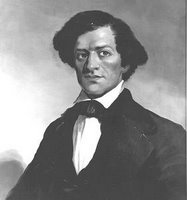David Ruggles and Frederick Douglass: Underground Railroad Agent and Passenger
 Ruggles was New York’s most visible conductor on the Underground Railroad. He claimed to have helped 400 fugitive slaves during the 1830s. One such escaped slave later became one of the most famous Americans of the 19th century. In his classic autobiography, Frederick Douglass recalled his dire straits just after he fled north to freedom in New York City in late September 1838. Though exhilarated by his newfound freedom, Douglass was terrified of slave catchers. The young fugitive was broke, lonely and spent several nights sleeping amidst empty barrels on the wharves. Fortunately, he met a sailor who took him to the print shop of David Ruggles, who sheltered him and welcomed him to freedom with great celebration. A few days later, Frederick was married to Anna Murray, a free black woman, in Ruggles’ shop in a ceremony led by James W.C. Pennington, a former fugitive turned Presbyterian minister. Immediately after the wedding, Douglass and his new wife traveled to New Bedford, Massachusetts, armed with a letter of recommendation from Ruggles and a $5 bill. In just a few years Douglass became one of America’s most famous abolitionist orators. Today, his autobiography is read by tens of thousands of college students and is considered a classic of American literature.
Ruggles was New York’s most visible conductor on the Underground Railroad. He claimed to have helped 400 fugitive slaves during the 1830s. One such escaped slave later became one of the most famous Americans of the 19th century. In his classic autobiography, Frederick Douglass recalled his dire straits just after he fled north to freedom in New York City in late September 1838. Though exhilarated by his newfound freedom, Douglass was terrified of slave catchers. The young fugitive was broke, lonely and spent several nights sleeping amidst empty barrels on the wharves. Fortunately, he met a sailor who took him to the print shop of David Ruggles, who sheltered him and welcomed him to freedom with great celebration. A few days later, Frederick was married to Anna Murray, a free black woman, in Ruggles’ shop in a ceremony led by James W.C. Pennington, a former fugitive turned Presbyterian minister. Immediately after the wedding, Douglass and his new wife traveled to New Bedford, Massachusetts, armed with a letter of recommendation from Ruggles and a $5 bill. In just a few years Douglass became one of America’s most famous abolitionist orators. Today, his autobiography is read by tens of thousands of college students and is considered a classic of American literature.From Graham Russell Hodges, "Hazards of Anti-Slavery Journalism," 2000
What I Saw at the Northampton Association, by Frederick Douglass, 1894
A little over a year before his death on February 20, 1895, Frederick Douglass agreed to reminisce about his visits to early Florence at the Northampton Association of Education and Industry. His remarks appeared in Charles Sheffeld's History of Florence, 1894 as "What I Saw at the Northampton Association." There he recorded his appreciation for Ruggles and his comrades at the Community:
Here, at least, neither my color nor my condition was counted against me. I found here my old friend, David Ruggles, not only black, but blind, and measurably helpless, but a man of sterling sense and worth. He had been caught up in New York City, recsued from destitution, brought here and kindly cared for. I speak of David Ruggles as my old friend. He was such to me only as he had been to others in the same plight. Before he was old and blind he had been a coworker with the venerable Quaker, Isaac T. Hopper, and had assisted me as well as many other fugitive slaves, on the way from slavery to freedom. It was good to see that this man who had zealously assisted others was now receiving assistance from the benevolent men and women of this Community, and if a grateful heart in a recipient of benevelonce is any compensation for such benevolence, the friends of David Ruggles were well compensated. His whole theme to me was gratitude to these noble people. For his blindness he was hydropathically treated in the Community. He himself became well versed in the water cure system, and was subsequently at the head of a water cure establishment at Florence. He acquired such sensitiveness of touch that he could, by feeling the patient, easily locate the disease, and was, therefore, very successful in treating his patients.
Portrait of Frederick Douglass, attributed to Elisha Hammond. Hammond was a member of the Northampton Association. Letters from Dolly Stetson to her husband James, recently published in Letters from an American Utopia, mention Douglass's portrait being painted during his visit in 1845.
Photo credit: National Portrait Gallery, Washington D.C

0 Comments:
Post a Comment
<< Home